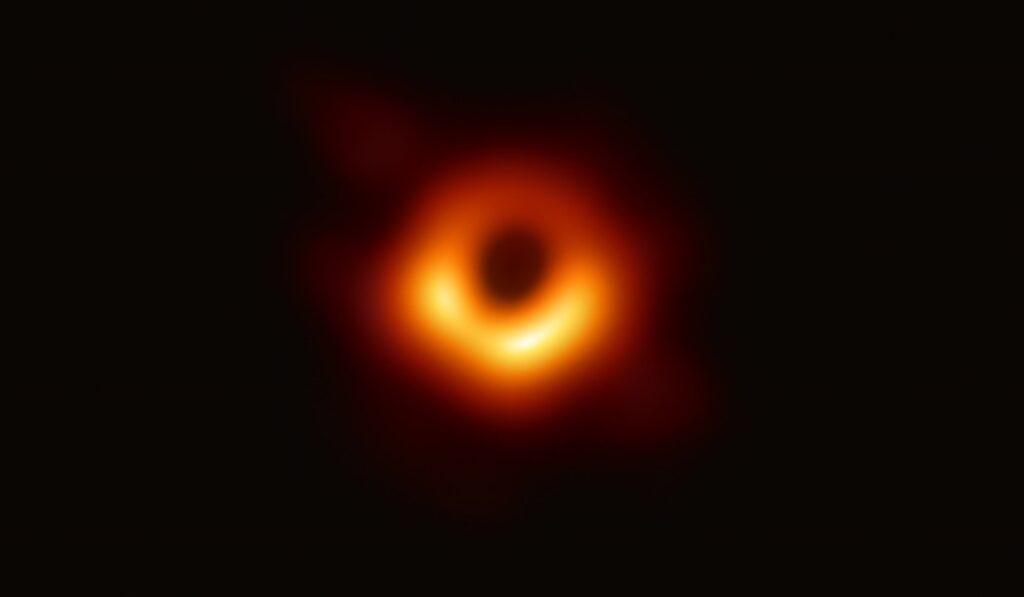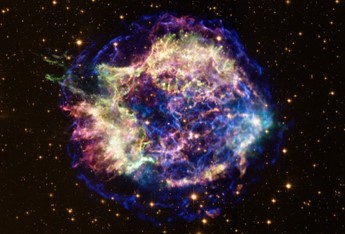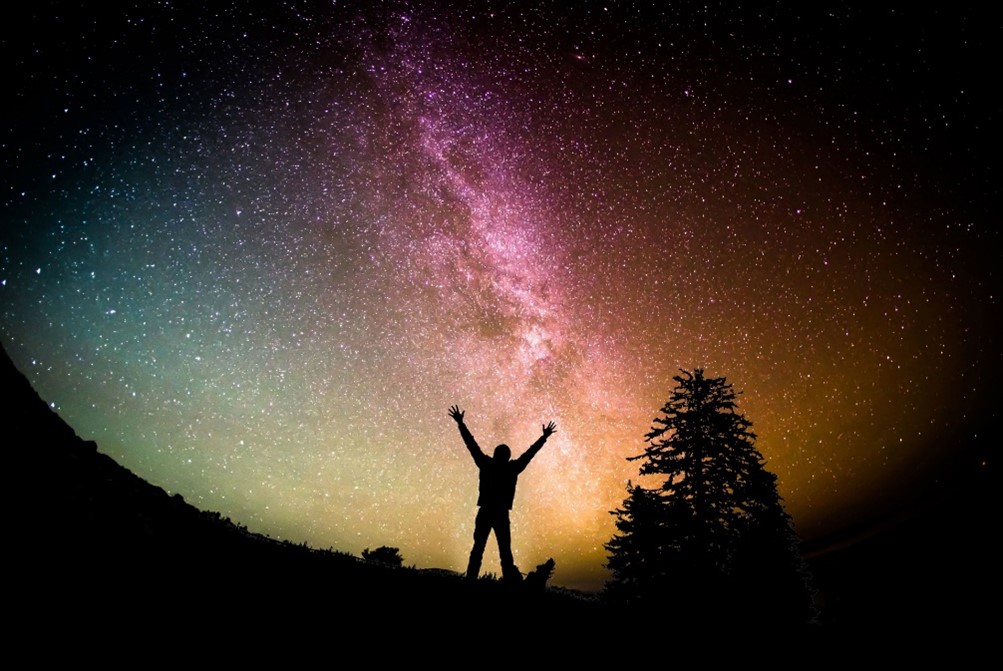
The first direct visual evidence of a supermassive black hole. Photo: Event Horizon Telescope.
Modern science uses quantum mechanics to explain the behavior of quanta, the smallest packets of energy in the universe, and general relativity to describe the dynamics of the largest astronomical objects.
However, this separation between the theories of small and large leaves important questions unanswered, such as what happens at the center of a black hole – where gravity appears to be so strong that not even light can escape it.
Since quantum mechanics first emerged a century ago, many have pursued a ‘Theory of Everything’ and failed – or are yet to succeed.
A new approach, however, might renew scientists’ hopes. By unifying our concept of time as it applies to both the smallest and the largest, we may better understand black holes and many other aspects of reality – and possibly get closer to time travel.
Albert Einstein’s theory of general relativity describes the behavior of physical objects as they are affected by gravity. In general relativity, time and space are part of the same entity, called spacetime, which operates as an integrated fabric.
The equations of general relativity predict how spacetime will bend around large masses – explaining, for instance, why and how planets orbit stars and moons orbit planets. They also describe how time is relative and slows down as objects move closer to the speed of light. But none of this seems to fit with our understanding of the world of the very small, the world of quantum mechanics and individual particles.
Gravity is difficult to apply to atoms and subatomic particles, whose behavior is explained by the other three fundamental forces of nature.
One of these, the electromagnetic force, is responsible for the interactions between both moving and stationary charged particles. The other two, the strong and weak nuclear forces, consist, respectively, of an attractive force between protons and neutrons that keeps the atomic nucleus together, and a force responsible for the radioactive decay of certain nuclei.
Quantum mechanics present seemingly odd phenomena, such as quantum superposition, which is the event when particles appear to be in two places and two states at once.
Another difficult to explain phenomenon is quantum entanglement, when information passes instantaneously between two far-apart particles and seems to defy the universal speed limit of light. The 2022 Nobel Prize in Physics was awarded for breakthrough research proving the existence of entanglement, although the reasons for specific patterns of entanglement remain unclear.
The difficulties in reconciling quantum mechanics with general relativity are increased by the measurement problems inherent in the quantum realm. For one, there’s the uncertainty principle, which is the fact that the more we know about a particle’s position the less we know about its velocity. Another measurement problem is presented by the observer effect, in which the act of observing quantum activity changes the outcome for reasons we haven’t yet been able to determine.
Connecting the theories of general relativity and quantum mechanics appears to be necessary as scientists strive to understand what happens at the center of black holes.
A black hole is born when the core of a massive star collapses in on itself. By the time an enormous star runs out of fuel, the outward pressure of nuclear fusion is no longer able to counteract the inward pull of gravity. As gravity continues to collapse the mass of the stellar core into an increasingly small space, a supernova explosion occurs and a black hole is formed. At the center of a black hole, as a result, there is an intense gravitational effect due to the compression of enormous mass into an infinitely small point. The center of a black hole is a point where both quantum mechanics and general relativity should reconcile.
However, these theories seem, at least so far, to be incompatible, and scientists have yet to unify them in what many call the “Theory of Everything”.
“A supernova is what happens when a star has reached the end of its life and explodes in a brilliant burst of light. Supernovae can briefly outshine entire galaxies and radiate more energy than our sun will in its entire lifetime. They’re also the primary source of heavy elements in the universe” (Space.com).
But Dr. Vlatko Vedral, from the University of Oxford, and his colleagues have cause for optimism.
They believe they may have found a way out of this unification problem. Time is a central concept to our understanding of reality, and Dr. Vedral argues that the apparent incompatibility arises from the way the concept of time differs between quantum mechanics and general relativity. In his view, changing how we understand time in quantum mechanics, by placing it in the same context of spacetime as in general relativity, may allow us to unify physics after all.

“This composite image shows an X-ray and optical view of Cassiopeia A, a supernova remnant located in our Galaxy about 11,000 light years away. These are the remains of a massive star that exploded about 330 years ago, as measured in Earth’s time frame”. Photo: NASA.
Many solutions have been proposed with this same goal, including string theory, which posits that there is a fundamental framework from which general relativity and quantum mechanics both evolve.
According to string theory’s advocates, all mass in the universe is made of very tiny, vibrating strings of energy, the smallest variable amount of which is the quantum. The strings combine and form what we observe as particles. However, string theory and other approaches to unify physics lack the experimental evidence that could back them up, scientifically speaking.
Dr. Vedral’s ideas resonate with the theories of quantum gravity.
As he explains, “these take ideas from general relativity – like spacetime, for example – and tweak them to fit quantum mechanics.”
His idea is that we treat space and time in the quantum world as we do in general relativity, as only one entity, the fabric of spacetime: “In relativity, time is interwoven with space. It can bend and stretch, depending on the speed or the gravity involved. This is a far cry from the way most physicists talk about time in quantum mechanics, where it is a fixed, separate entity, a series of steps through which interactions evolve and nothing more. In traditional quantum mechanics, time is only inferred from looking at other observable quantities, such as the hands of a clock.”
In Dr. Vedral’s model, quantum objects exist not at one specific time, but instead across all spacetime simultaneously.
“When making calculations about how a particle should interact, for example, we write down all the possible outcomes at all the possible points in space and every instance of time, instead of just at one instance of time as is normally done with the Schrödinger equation”. As a result, just like in general relativity, time in quantum mechanics becomes relative.
“Conceptually, the Schrödinger equation is the quantum counterpart of Newton’s second law in classical mechanics. Given a set of known initial conditions, Newton’s second law makes a mathematical prediction as to what path a given physical system will take over time. The Schrödinger equation gives the evolution over time of a wave function, the quantum-mechanical characterization of an isolated physical system” (Wikipedia).
“What this means is that when you are looking at two descriptions of a position in spacetime, for example, it isn’t always possible to say whether one happened before the other,” Dr. Vedral said. In other words, just like in general relativity, positions in spacetime depend on the observer. Spacetime, according to this framework, would be “an entangled web of quantum-correlated events all given in advance”, explains Dr. Vedral.
This idea was first introduced in a paper in 2015 led by his colleague and co-author Dr. Joseph Fitzsimons, from the Berkley Institute. Now, Dr. Vedral and his team are going further and empirically testing these proposals.
“I am very optimistic about testing the interface between quantum physics and the theory of gravity, that we call general relativity. (…) These two theories have never been tested at the same time. We are trying to find the domain where both quantum mechanics and gravity play an important role. This is quantum gravity. There are many theoretical proposals, but no one has really done any tests. (…) I think already within the next 10 years we will get some very fundamental results that may force us to rethink the foundations of physics”, says Dr. Vedral.
The group of researchers has already performed some experiments to illustrate their approach, with exciting results.
They have so far demonstrated that, by using their mathematical framework and considering spacetime as a single entity, we can describe quantum states just as easily as the alternatives.
Although there is an important and intrinsic advantage of being one step closer towards a unifying theory of physics, the scientists now need to test how empirically superior the new approach actually is, compared to the standard version. As technology advances, they are optimistic they will soon be able to put their full theory to the test.

As time passes, humans come closer to understanding the nature of time and reality itself. Photo: Gerhard Lipold.
If they are right, it could mean that at the center of a black hole the region of spacetime is so small that space and time cannot be differentiated from one another.
The problem of the singularity that seems to remain unsolvable in general relativity is eliminated if the uncertainty principle of quantum mechanics is extended to all of spacetime.
That’s because the inability to measure both particle position and velocity at the same time would mean that neither space nor time could have the precise value of zero simultaneously, which is the mathematical challenge of the singularity problem. Furthermore, extending the uncertainty principle to the entire fabric of spacetime could lead to a form of time travel.
Problem of the singularity: “One of the major issues in general relativity that separates it from other descriptions of the universe, like quantum physics, is the existence of singularities. Singularities are points that when mathematically described give an infinite value and suggest areas of the universe where the laws of physics would cease to exist — i.e. points at the beginning of the universe and at the center of black holes” (SciTechDaily).
The idea of quantum time travel has to do with closed time-like loops, which are “theoretical loops created when spacetime curves so much that it closes in on itself – a route, it might seem, to the past,” explains Dr. Vedral.
Until recently, closed time-like loops have been dismissed since they are prohibited by the standard version of quantum mechanics. Now, however, a new window is opening – to the center of black holes, to the past, and what seems to be the future of our understanding of the universe we call home.



